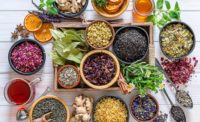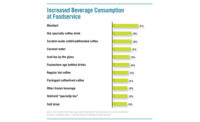Time for Tea

With the 2011 World Tea Expo in full swing June 24-26, George Jage, founder and president of World Tea Media, granted Prepared Foods an interview about tea’s growth and how the food and beverage industry can take advantage of this sector. He shared insights on the latest tea trends, noteworthy business challenges with tea and developments in bottled and canned teas. In addition, Jage and his company are gearing up for the launch of World Tea East, September 9-10 at the Pennsylvania Convention Center in Philadelphia.
Prepared Foods: Tea is gaining more attention with media, consumers and the food and beverage community in general. Why is this?
Jage: The short answer is that this is a natural convergence of two powerful market factors. First, the U.S. is the largest consuming nation in the world. And, second, tea is the most consumed beverage in the world -- second only to water -- but ranks the seventh most consumed in the United States. The natural shoring of the gap of U.S. consumption is being facilitated by the globalization of our economy, the emerging U.S. awareness of tea’s health benefits, and the increased importation and subsequent availability of high quality specialty and premium tea to the American consumer.
The two largest living generations in America, the Baby Boomers and Millennials, are making significant contributions to the U.S. market growth. The Baby Boomers are a “forever young” generation, who are entering retirement age for the first time. They are embracing healthy living practices and becoming more conscious of their daily diets. Tea is a panacea for this generation, offering great taste, a wide variety, nominal calories, and a score of perceived health benefits based on research such as reduced cardiovascular disease, lower cholesterol and a reduced risk of certain cancers, like prostrate and colon.
The Millennials are also driving market growth though their inherent global connectivity and social awareness. Fair trade and organic teas score well with this generation. They also thirst for being able to “discover” things to share with their peers through their social networks, both electronically and in the real world. There are literally thousands, if not tens of thousands, of different varieties of tea when you factor in the different blends with fruit, floral and flavoring.
PF: What do you think are the most important issues or topics from this year’s World Tea Expo?
Jage: I think the biggest question for the industry is “How do we manage our collective success moving forward?” In the nine years since I started the event, I have seen massive transformation of the industry. Nine years ago, mentioning a tea room conjured images of a rural antique shop with a Victorian setting or afternoon tea at the Plaza in New York. In recent years, there has been an explosion of new concepts and the emergence of several large chains contending to be the “Starbucks” of tea. As a matter of fact, it was nearly 20 years ago that Starbucks began trading publically. This year, the largest U.S. tea retail chain, Teavana, announced plans to go public to raise $100 million to fund their future expansion. In the early 1990s, we all were curious what a $4 cup of coffee would taste like.
PF: For those in R&D, technical, marketing, purchasing and other key positions at food and beverage companies, what do they need to know about today’s tea opportunity?
Jage: In product development, I feel the emphasis needs to be on quality. Take Honest Tea as a real-world example. When Seth Goldman and his partner started the company, it was the idea of creating a low-sugar, great-tasting tea -- something that existed outside the U.S. but a completely foreign concept to the U.S. market. Now, Honest Tea is owned by Coca-Cola and is expected to exceed $100 million in total sales volume soon.
Currently, there is a lot of opportunity for product development and market introduction, but over time, consumers will demand higher quality and the real deal. Men’s Health, a few years back, published a blind study to see which bottled teas actually had tea in them and how much. I don’t think this article had a huge impact on sales, but again, as the market grows, this type of consumer awareness will become more and more influential.
PF: Are there any noteworthy business challenges within the tea sector at the moment, and how can food and beverage professionals address those challenges?
Jage: The FDA recently doled out a series of warnings to several tea brands, inferring or claiming the health benefits of tea. They even went on to state that tea is not even GRAS (generally recognized as safe). While this may seem ludicrous, the reality is that very little has been done to allow the tea industry to effectively and clearly market its health message. The specialty and premium tea companies, in particular, need to come together to effectively address how to overcome this obstacle for the future. Just imagine the impact on tea sales in the U.S., if the tea companies could market just a fraction of the scientifically proven health benefits of tea?
PF: Let’s talk about some of the tea trends. What are the biggest trends in tea right now?
Jage: There are quite a few in the industry that the industry is still defining itself, but one that I see has the most promise in the U.S. is the emergence of enhanced or functional teas. Tea, in itself, is a functional beverage, but with the popularity of energy drinks and enhanced water, we are seeing a tremendous amount of new products enhanced for specific purposes such as boosting energy, concentration or for better sex.
PF: What developments are you seeing in terms of ready-to-drink (RTD) teas, or bottled and canned teas?
Jage: RTD continues to show double digit growth year over year. In 2009, amidst a global economic meltdown, only two segments of the RTD market grew, energy drinks and tea. All the major CSD companies are looking to expand their portfolio with soda sales going flat.
As I mentioned, the U.S. is the largest consuming nation, we also are a here-and-now instant gratification culture. The market is still small for people looking to truly take in the benefits of tea, meaning, taking the time to brew the tea, watching the agony of the leaves as they unfurl and drinking tea for community or meditation. Ironically, the health benefit from truly sharing a pot of tea and a conversation, or merely taking the time to be reflective, is what is most needed in our culture. So for now, a majority of tea drinkers want it simple, and if it is already brewed and ready, then all the better.
PF: What are you seeing in the market in terms of quality tea, and how are consumers responding?
Jage: I am definitely seeing improvements in quality and the consumer demanding it. Lipton has been far more aggressive in marketing its premium Pure Leaf brand than I have seen it market Lipton Brisk. But quality is a double-edged sword, as there is only so much quality tea produced globally, and growers have a lower yield for higher quality. So, as the market grows, the producers will need to keep ahead of the demand for higher quality product or it will restrain the market or decrease the quality overall.
To learn more, visit www.WorldTeaEast.com or www.WorldTeaExpo.com.
Looking for a reprint of this article?
From high-res PDFs to custom plaques, order your copy today!





